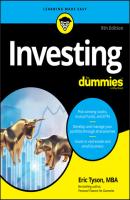Investing For Dummies. Eric Tyson
Чтение книги онлайн.

Читать онлайн книгу Investing For Dummies - Eric Tyson страница 23
Название: Investing For Dummies
Автор: Eric Tyson
Издательство: John Wiley & Sons Limited
Жанр: Личные финансы
isbn: 9781119716518
isbn:
Small-business returns
As I discuss in Part 4 of this book, you have several choices for tapping into the exciting potential of the small-business world. If you have the drive and determination, you can start your own small business. Or perhaps you have what it takes to buy an existing small business. If you obtain the necessary capital and skills to assess opportunities and risk, you can invest in someone else’s small business.
What potential returns can you get from small business? Small-business owners like me who do something they really enjoy will tell you that the nonfinancial returns can be major! But the financial rewards can be attractive as well.
Every year, Forbes magazine publishes a list of the world’s wealthiest individuals. Perusing this list shows that most of these people built their wealth by taking a significant ownership stake and starting a small business that became large. These individuals achieved extraordinarily high returns (often in excess of hundreds of percent per year) on the amounts they invested to get their companies off the ground.
You may also achieve potentially high returns from buying and improving an existing small business. As I discuss in Part 4, such small-business investment returns may be a good deal lower than the returns you may gain from starting a business from scratch.
Unlike the stock market, where plenty of historic rate-of-return data exists, data on the success, or lack thereof, that investors have had with investing in small private companies is harder to come by. Smart venture capitalist firms operate a fun and lucrative business: They identify and invest money in smaller start-up companies that they hope will grow rapidly and eventually go public. Venture capitalists allow outsiders to invest with them via limited partnerships. To gain entry, you generally need $1 million or so to invest. (I never said this was an equal-opportunity investment club!)
Venture capitalists, also known as general partners, typically skim off 20 percent of the profits and also charge limited partnership investors a hefty 2 to 3 percent annual fee on the amount that they’ve invested. The return that’s left over for the limited partnership investors isn’t stupendous. According to Venture Economics, venture funds have averaged comparable annual returns to what stock market investors have earned on average over this same period. The general partners that run venture capital funds make more than the limited partners do.
You can attempt to do what the general partners do in venture capital firms and invest directly in small private companies. But you’re likely to be investing in much smaller and simpler companies. Earning venture capitalist returns isn’t easy to do. If you think you’re up to the challenge, I explain the best ways to invest in small business in Chapter 15.
Considering Your Goals
How much do you need or want to earn? That may seem like an extraordinarily silly question for me to ask you. Who doesn’t want to earn a high return? However, although investing in stocks, real estate, or a small business can produce high long-term returns, investing in these vehicles comes with greater risk, especially over the short term.
Some people can’t stomach the risk. Others are at a time in their lives when they can’t afford to take great risk. If you’re near or in retirement, your portfolio and nerves may not be able to wait a decade for your riskier investments to recover after a major stumble. Perhaps you have sufficient assets to accomplish your financial goals and are concerned with preserving what you do have rather than risking it to grow more wealth.
If you work for a living, odds are that you need and want to make your investments grow at a healthy clip. If your investments grow slowly, you may fall short of your goal of owning a home or retiring or changing careers.
Chapter 3
Getting Your Financial House in Order
IN THIS CHAPTER
Before you make any great, wealth-building investments, I recommend that you get your financial house in order. Understanding and implementing some simple personal financial management concepts can pay off big for you in the decades ahead.
You want to know how to earn healthy returns on your investments without getting clobbered, right? Who doesn’t? Although you generally must accept greater risk to have the potential for earning higher returns (see Chapter 2), in this chapter, I tell you about some high-return, low-risk investments. You have a right to be skeptical about such investments, but don’t stop reading this chapter yet. Here, I point out some of the easy-to-tap opportunities for managing your money that you may have overlooked.
Establishing an Emergency Reserve
You never know what life will bring, so having a readily accessible reserve of cash to meet unexpected expenses makes good financial sense. If you have a sibling who works at a well-paying and secure job or a financially secure and understanding parent, you can use one of them as your emergency reserve. (Although you should ask them how they feel about that before you count on receiving funding from them!) If you don’t have a wealthy family member, the ball’s in your court to establish a reserve.